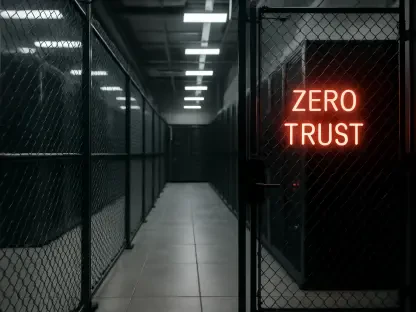In the current landscape of sophisticated cybersecurity threats, federal agencies are undergoing a transformative shift that heralds a new era in digital defense. Moving beyond the traditional focus on perimeter defenses, these agencies are embracing a zero trust architecture that fundamentally redefines how security is perceived and executed. This approach is grounded in the principle that no entity, whether internal or external, can be implicitly trusted. This mindset assumes that adversaries might already be present within the network, and thus emphasizes rapid detection and response over mere prevention.
The Fundamental Shift to Zero Trust
The adoption of zero trust is not merely a technological enhancement but a revolutionary change in both strategic thinking and operational procedure. This methodology is anchored in adaptive, data-driven security strategies that prioritize resilience under the presumption of potential intrusions. Instead of relying heavily on defense measures alone, federal agencies are integrating comprehensive visibility solutions across applications, databases, endpoints, and user activities. The key is to dynamically validate access and permissions using telemetry data, which significantly bolsters their ability to identify and mitigate threats in real time.
Integral to this approach is the shift from automatic trust to a regimen that continuously verifies every access request. Drawing on modern data analytics, agencies are better positioned to evaluate risks instantaneously based on various criteria such as user identity, device compliance, and geographical location. This paradigm shift reflects a move from viewing security like a fortified perimeter to a more nuanced approach akin to an urban grid with layers of protection. Every digital interaction is now scrutinized, ensuring that every component, be it a device or system, is continuously assessed for potential compromise.
AI: The Catalyst in Zero Trust Security
Central to the modern effectiveness of zero trust architecture is the integration of Artificial Intelligence (AI), which serves as a catalyst in enhancing cybersecurity operations. AI’s role as a force multiplier allows agencies to augment their detection capabilities, fortify protective measures, and offer vital support to security analysts in real time. Initially characterized by the development of machine learning models, AI has now evolved into large language models that provide scalable solutions, significantly expediting threat detection and enabling multilingual threat analysis.
These AI systems act as vital aids rather than replacements for skilled security professionals. Functioning as enhancements to human workloads, they assist in risk scoring, alert prioritization, and uncovering latent threats that might otherwise escape attention. Agencies that have adeptly integrated AI into their existing security workflows report markedly improved outcomes, highlighting the shortcomings of a one-size-fits-all approach where AI tries to supplant human oversight. As agencies amplify their threat detection capabilities, AI plays an essential role in interpreting vast datasets, thus spotlighting prolonged and subtle attack campaigns that may extend over extended periods.
Enhancing Detection and Response Capabilities
The evolution towards zero trust is inexorably linked with the operational overhaul of Security Operations Centers (SOCs), which are tasked with real-time threat analysis and incident response. These centers are collaborations between SOCs and Network Operations Centers (NOCs), providing the necessary infrastructure and capabilities to isolate and counter threats quickly. This partnership ensures the continuous monitoring and adaptive responses that hallmark zero trust security.
A critical departure from traditional security frameworks, zero trust emphasizes the necessity for layered protections at every level of the digital environment. Identity management emerges as a keystone theme in the zero trust narrative, where user and device identities are meticulously tracked. Access decisions are contingent on aligning these identities with predefined trust thresholds, ensuring that sensitive data remains secure. For instance, while a compliant user on a recognized device may be granted access, deviations from these norms trigger more stringent security protocols, accepting nothing as trusted by default.
Implementing Zero Trust Strategies
Before they can reap the benefits of AI-enhanced zero trust strategies, agencies need to establish robust foundations centered on comprehensive visibility. Deploying sensors across cloud, on-premises, and hybrid environments is crucial for identifying assets and monitoring system behavior. This “sensor-up” methodology is paramount for detecting overlooked risks and lays the groundwork for the effective implementation of AI-driven solutions.
With this visibility secured, agencies can proceed with relationship mapping and behavioral analysis to pinpoint high-value assets and the systems crucial to their operation. This understanding is critical for protecting essential data and minimizing attack surfaces. Adversaries often view networks in terms of relationships rather than isolated segments, so identifying interactions between identities and sensitive data is fundamental for robust threat modeling and defense planning.
Furthermore, zero trust requires a meticulous approach to data governance, emphasizing data-centric policies. Data classification remains critical, even in environments considered unclassified, due to varying levels of data sensitivity. While some data may be publicly accessible, other information, such as Controlled Unclassified Information (CUI), demands more rigorous controls. Agencies must align access policies with data classifications, considering factors like device type, application, and encryption needs to ensure that data remains secure regardless of its location.
Towards a Secure Future
In today’s complex cybersecurity environment, federal agencies are undergoing a significant transformation, marking a new chapter in digital security. Traditionally, the focus was on perimeter defenses, but now there’s a shift towards a zero trust architecture. This change fundamentally alters the way security is conceptualized and implemented. The core principle of zero trust is that no entity, whether it is inside or outside the network, is automatically trusted. This approach is based on the idea that threats may already exist within the network boundaries, putting emphasis on swift detection and response rather than solely on prevention. Such a strategy requires continuous verification and rigorous access controls, treating every access attempt as a potential threat. The new philosophy is proactive, involving constant monitoring and verification of users and devices before granting access. This strategy enhances resilience against breaches, ensuring more robust digital defenses to counter evolving cyber threats and protect sensitive data.









